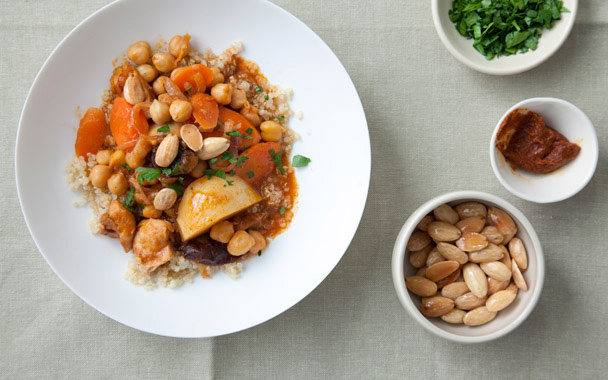Couscous, along with mahimahi and sweet Walla Walla onions, are verbal booby traps in our household: The mere mention of any of them immediately elicits the wisecrack, “I heard you the first time.” I’ve been the butt of that family joke a lot lately because I’ve been on a couscous kick. Not your regular five-minute couscous, though, but rather quinoa cooked like couscous.
So what’s my problem with couscous? It isn’t a whole grain but a form of pasta, and at home, I’m on a perpetual mission to maximize fiber and nutrition. Quinoa, an ancient staple of the Incas, can, like couscous, be found on supermarket shelves and although it’s an herb, botanically speaking, it’s commonly lumped in with the whole-grain crowd. You could easily mistake it for couscous because it’s about the same size and, when cooked and served alongside brothy stews, it behaves the same way, absorbing the juices. It’s also a terrific source of protein, providing more than any grain.
But health isn’t all I care about. Time is paramount, and what clinches the quinoa deal for me is the fact that, unlike most whole grains, it cooks quickly, in about 20 minutes—half the time of brown rice or barley. Getting to love quinoa, however, involved some experimentation. Take it from me: Don’t skip rinsing it well. I know it’s tempting—it looks pristine—but it has a bitter natural coating called saponin, which is easily removed in this crucial first step.
Years ago, when I first began to work quinoa into my kitchen repertoire, I followed the usual directions for cooking it in a measured amount of water (two parts water to one part grain), it felt wet and heavy, even though all the liquid had been absorbed. I eventually solved my problem with that texture back in 1994, while developing recipes for a Gourmet feature on grain salads: Cook it in lots of boiling salted water for 10 minutes, then drain and steam it over a small amount of boiling water to dry it out and fluff it up. That’s been my favorite method ever since.
Several weeks ago, I threw together a quick Moroccan chicken stew on one of those nights when all I had in the fridge were two lonely boneless skinless chicken thighs and some onions, carrots, and turnips. The spices I tossed in were cupboard stand-bys: paprika, cumin, ginger, and cinnamon. While the stew simmered on the stove, I steamed some quinoa. Talk about stretching half a pound of chicken to serve four people: Those two thighs, combined with a can of chickpeas and some prunes and spooned over the hot quinoa, were a protein feast. Any dish that goes over well the first time gets repeated in my house. And yes, I heard you the first time.




 Pinterest
Pinterest


